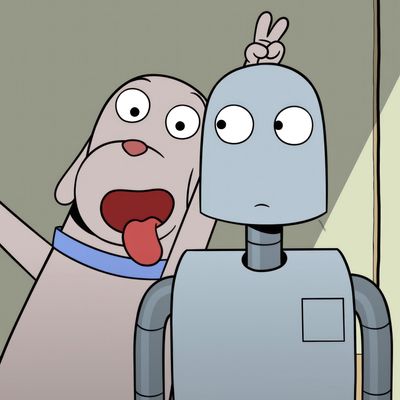
It was a stroke of genius for Spanish director Pablo Berger to adapt Sara Varon’s 2007 book, Robot Dreams — the story of a dog and its pet robot in mid-1980s New York — as a hand-drawn animated fable. The film, which was nominated for the Best Animated Feature Oscar earlier this year, could just as easily have been made with computer graphics, the dominant style of most mainstream animation nowadays; indeed, at some point, that was reportedly the plan. But computer animation would have grounded the movie in something closer to the real world. And that would have been catastrophic. In Robot Dreams, the bold clarity of the line drawings matches the clean simplicity of the plot — which, perhaps ironically, fires our imaginations even further. The movie’s entrancing and melancholy beauty feels old-fashioned in a contemporary animation world largely defined by clutter and smarm.
With zero dialogue, the film follows a lonely dog (known simply as Dog) who purchases a robot companion by mail. Dog assembles Robot, and the two of them proceed to spend a wonderful summer in the overcrowded, sweaty city. (The whole world is populated by animals; there are no people here, as far as I can tell.) One day, they take a bus way out to the beach and cavort joyfully in the waves. Afterward, however, Robot breaks down and can’t move its limbs. After anxiously trying to move this large metal hulk, Dog leaves for home to figure out how to fix the problem. But the beach is now closed and gated until the following summer, and despite many efforts, Dog can’t reach Robot, who lies there in the sand, fantasizing of ways that they might be reunited.
The bulk of Robot Dreams follows the two protagonists during their separation. The always awkward Dog finds another companion — a cool and confident moped-riding Duck in Air Jordans and sunglasses — while Robot has encounters with the rest of the world that are sometimes dreams, sometimes real. During these moments, Berger tugs at our heartstrings with a mixture of gentle warmth and understated sadism. There are a couple of absolutely brutal cuts in the film that make us wonder if it’s headed in a decidedly more horrific direction. (Lest I make it sound like you couldn’t enjoy Robot Dreams with your kids, let me assure you: Children will likely adore this picture.)
The occasional patches of darkness are all part of the growing metaphorical power of the film. Though the story seems to take place over the course of one year, we see the city change around these characters. We see Dog grow into a different … person? (Is that the word?) We see Robot exposed to the cruelty and indifference of the world, but also to its offhand kindnesses. We see a kind of love develop between characters. Whether that’s the love of friendship or something akin to romance, Berger largely leaves that up to us.
Throughout, the animation is clear, simple, and specific — it incorporates New York landmarks both big and small, from Central Park to El Quijote. But that, too, adds to the evocative quality of the film. The World Trade Center towers dominate the city’s skyline, perhaps even more than they once did in real life. The ubiquity of the Twin Towers suggests that Berger has a lot more on his mind than just this basic tale of friendship. Or rather, he understands that the world around us shifts along with our relationships — and vice versa. Watching Robot Dreams, we find ourselves reflecting on how our own lives have changed as we’ve grown: the friends we’ve left behind but haven’t forgotten, the cities that have transformed around us, the wisdom we’ve accrued, and all the ways in which we’re still slightly damaged from all that living.


